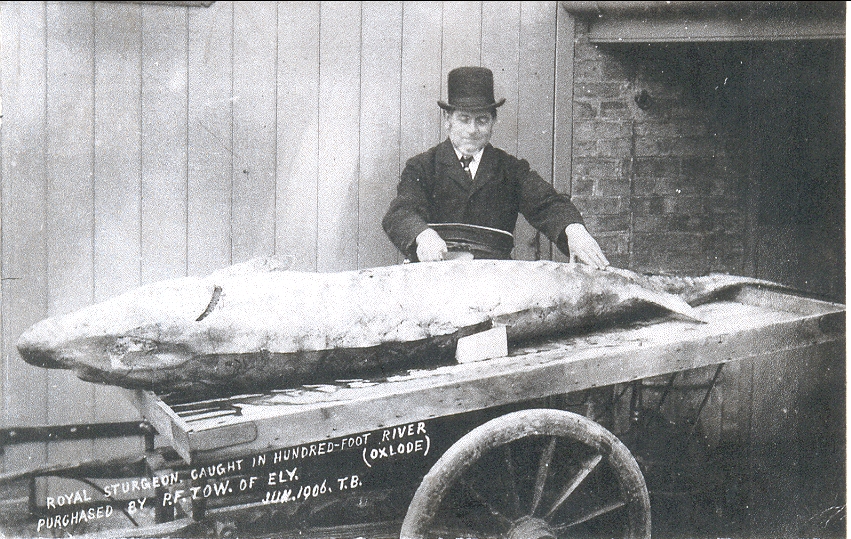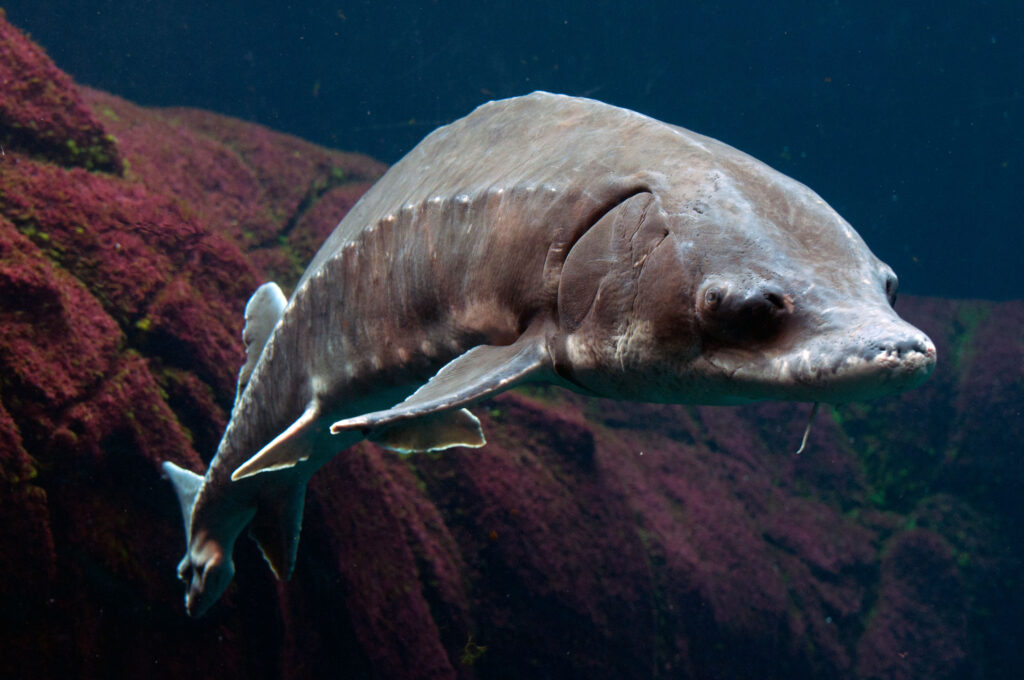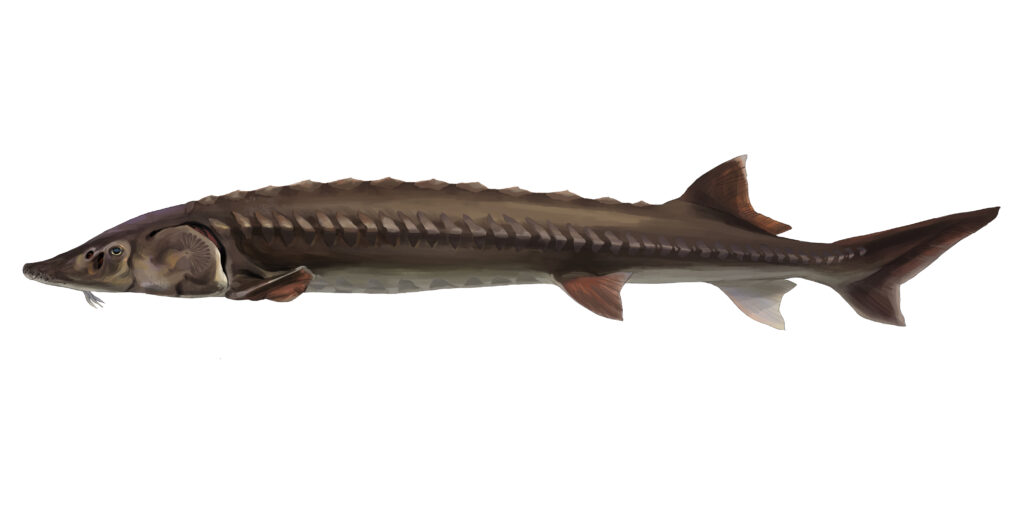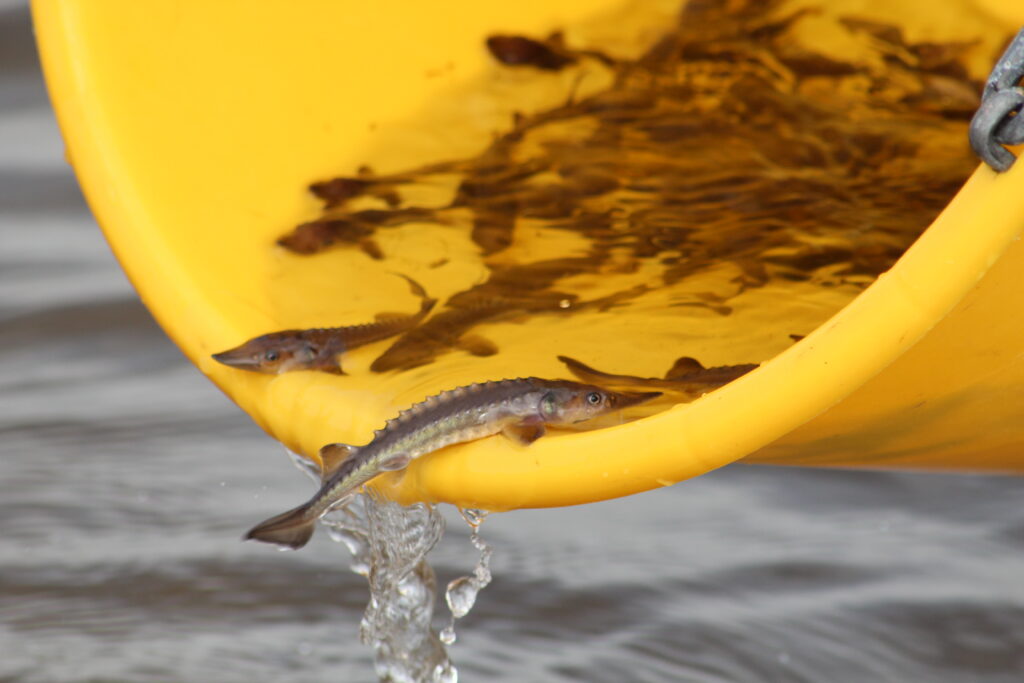The UK was once home to two species of sturgeon, prehistoric marvels of nature known as “dinosaur fish”. Alex Hubberstey, BLUE’s UK Sturgeon Coordinator, describes how both arrived in the UK thousands of years ago, one by an incredible trans-Atlantic journey, and peacefully co-habited UK waters until human pressures wiped them out.
In 1495, the Danish King Hans sent his flag ship, the Gribshunden, laden with gifts across the Baltic Sea to gain the favour of Sten Sture the Elder, and lay claim to the Swedish throne. Sadly, the ship, crew and royal goods never made it, sinking to the bottom of the sea. Over 500 years later, in 2020, the wreck was discovered. Due to the unique conditions of the Baltic Sea, much of the ship and the goods inside were well–preserved, including the remains of a two-metre-long sturgeon.
Sturgeon have outlived the dinosaurs, surviving multiple mass–extinctions and ice ages. Despite this, they have had little reason to change over the last 200 million years. They cruised the waters of the early Jurassic, likely encountering Dilophosaurus in the early days and the mighty Tyrannosaurus Rex millions of years later. Instead of scales, sturgeon are covered in armoured plates known as scutes, which provide protection from predators and illustrate their prehistoric heritage. They are incredibly strong, with some historic records recounting how teams of oxen were needed to pull these fish from the water. Most are bottom feeders, gentle giants posing no threat to humans, and yet we have hunted them relentlessly, to the brink of extinction.

In the UK, two species of sturgeon once thrived in our waters before being completely wiped out in the 1990s. One being the aptly named Atlantic (or Baltic) sturgeon (Acipenser oxyrinchus), which made the journey over the Atlantic Ocean to Europe thousands of years ago. This large, slow–growing species can live for 60 years and grow to almost five metres in length, but they can be even bigger; a fish caught in the Hudson River in New York in 2019 was estimated to be over 80 years old and around 4.3 metres in length. They are anadromous, meaning that they are born, and then later spawn, in freshwater but will spend the interim years in saltwater. They tend to prefer the shallower coastal waters where they eat worms, molluscs, crustaceans and small bottom-dwelling fish.

Sturgeon are not found in deep waters, making the Atlantic sturgeon’s decision to cross the Atlantic Ocean to settle in Europe’s waters even more bizarre. As a migratory species, vast journeys over thousands of miles are nothing new, but this journey from North America to Europe stands out among them all. As Jörn Gessner (of the Leibniz-Institute of Freshwater Ecology and Inland Fisheries – IGB) puts it, “The extraordinary issue is the fact that as a benthic* fish, they have crossed the Atlantic without ever seeing the bottom of the waterbody.”
*Benthic means they spend their time traveling along the bottom of a river or sea.
In ancient times, this species was found in most major rivers along the eastern coast of North America, from the Gulf of Mexico to Newfoundland. The Native Americans even based the legend of the Mashenomak (the Great Fish) on a sturgeon. This was its natural range until a small proportion of individuals, estimated to be somewhere between ten and 60, made the decision to cross the second largest ocean in the world and establish a population in the Baltic Sea.
The time this journey took place has been widely debated in the field. Recent findings show that Western Europe, notably the French Atlantic Coast and subsequently the North Sea, was inhabited by this species at the latest, 3,000 years ago. Over time, ice sheets across Northern Europe melted, aiding the expansion of the Atlantic sturgeon population in many rivers from the Baltic Sea to the Bay of Biscay. But Europe had another sturgeon species on the rise, the European sturgeon (Acipenser sturio). As the Atlantic sturgeon arrived, the Europeans were just starting to expand from the Mediterranean. Over an extended period, the European sturgeon’s range increased to most of the European continent, from the Mediterranean to Scandinavia, replacing the Atlantic sturgeon in Western Europe. By spending more time in estuaries before migrating, Atlantic sturgeon compete among themselves for resources, resulting in smaller populations. In contrast, European sturgeon, by migrating to sea earlier, can utilise a wider array of resources more efficiently. It has been a common misconception that Atlantic sturgeon replaced the Europeans in the Baltic Sea, when the reality is that the Europeans eventually started to establish a foothold there. Sadly, both species succumbed to human pressures before one could become dominant.
Atlantic and European sturgeon are close relatives, almost indistinguishable from each other in appearance unless you know what to look for (slight differences in body shape, structure of the scutes, head proportions and dorsal fin shape).

Today, sturgeon are the most critically endangered group of species on the planet according to the International Union for the Conservation of Nature (IUCN). They have a long history of decline, with human exploitation reported from the Bronze Age and the last individual being captured in a UK river in the early 1990s.
It is now known that the UK was a crossover range for the Atlantic and European sturgeon, meaning both frequently used the same spawning rivers. Both species co-habited UK and European waters for thousands of years before being decimated by human pressures. There is even evidence of both these species still living in the UK over the past 500 years. The UK Sturgeon Database, created by Steve Colclough of the UK Sturgeon Alliance, has identified over 1,400 sturgeon in UK rivers since the early 1600s. A further 3,600 have been found occupying our coastal waters. Although the exact species distribution is currently unknown in the UK, it has been theorised that Atlantic sturgeon were found in the colder northern waters, from the east coast of Scotland down to the Humber whilst the remainder of the country possessed European sturgeon populations.
As a member of the UK Sturgeon Alliance, Blue Marine Foundation (BLUE) is aiming to restore native populations of our largest freshwater fish starting in the Greater Severn catchment. This is being done in parallel with restoration schemes already happening in France, Germany and the Netherlands for both species. Sturgeon from European restoration schemes have begun cropping up once again in UK waters. Since 2016 there have been six sturgeon captures around the southern coast, three of each species. The most recent of these individuals was caught off Brixham on 10 August 2020 and measured in at just under one metre. Based on the precedent set by restoration schemes on the continent, the UK is now in a strong position to begin restoring populations of both species.

Sturgeon restoration will not be a quick fix. These ancient beings take upwards of twenty years before they can spawn. But with the removal of river barriers like weirs and dams, and the restoration of their habitat, we can give them a fighting chance. King Hans and other members of royalty prized sturgeon for a reason. These fish are special. As the story of the Gribshunden shows us, they once had a wealth that could help someone claim a throne. By recognising this incredible species and doing what is necessary to enable their return, I hope one day, in the not-too-distant future, to be witnessing a great spawning migration of sturgeon in a UK river – the long-awaited return of the Royal Dinosaur Fish.


















